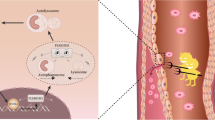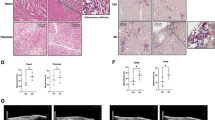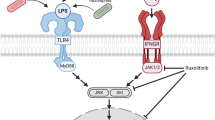Abstract
Purpose
Our study aimed to investigate the function of Cavin-1 and SOCS3 in macrophages/microglia M2 polarization and further explored the relevant mechanism.
Methods
Expression levels of Cavin-1 and SOCS3 in macrophages/microglia were measured by western blotting and RT-PCR, respectively. Then, Cavin-1 or SOCS3 was gene silenced by a siRNA approach, and gene silencing efficiency was determined by western blotting. Next, co-immunoprecipitation (Co-IP) was employed to further analyze the interaction between Cavin-1 and SOCS3. Finally, the activation of STAT6/PPAR-γ signaling was evaluated using western blotting, and the M2 macrophages/microglia polarization was validated by measuring the mRNA expression of M2 markers by RT-PCR.
Results
In the polarization process of macrophages/microglia to M2 phenotype, both Cavin-1 and SOCS3 increased synchronously at protein and mRNA level, reached the peak at the 6 h, and then decreased. After Cavin-1 or SOCS3 silencing, the expression of Cavin-1 and SOCS3 declined. These results suggested that Cavin-1 and SOCS3 were positively correlated in macrophages/microglia, and this conjecture was verified by Co-IP. Besides, Cavin-1 silencing not only suppressed the activation of STAT6/PPAR-γ pathway, but also suppressed the release of anti-inflammatory factors. Finally, we found that SOCS3 overexpression reversed the inhibitory effect of Cavin-1 silencing on the release of anti-inflammatory factors in M2 macrophages/microglia.
Conclusions
Cavin-1 and SOCS3 are actively involved in the process of M2 macrophages/microglia polarization. As a SOCS3 interacting protein, Cavin-1 can promote M2 macrophages/microglia polarization via SOCS3.






Similar content being viewed by others
References
Hajdusianek W, Żórawik A, Waliszewska-Prosół M, Poręba RGP. Tobacco and nervous system development and function-new findings 2015–2020. Brain Sci. 2021;11(6):797.
Frank-Cannon TC, Alto LT, McAlpine FE, Tansey MG. Does neuroinflammation fan the flame in neurodegenerative diseases? Mol Neurodegener. 2009;4:47.
Zhang C, Hu L, Liu D, Huang J, Lin W. Circumdatin D exerts neuroprotective effects by attenuating lps-induced pro-inflammatory responses and downregulating acetylcholinesterase activity in vitro and in vivo. Front Pharmacol. 2020;11:760.
Ploquin MJ, Jacquelin B, Jochems SP, Barré-Sinoussi F, Muller-Trutwin MC. Innate immunity in the control of HIV/AIDS: recent advances and open questions. AIDS. 2012;26(10):1269–79.
Davis MJ, Tsang TM, Qiu Y, Dayrit JK, Freij JB, Huffnagle GB, Olszewski MA. Macrophage M1/M2 polarization dynamically adapts to changes in cytokine microenvironments in cryptococcus neoformans infection. MBio. 2013;4(3):e00264-e1213.
Zhou J, Li Z, Wu T, Zhao Q, Zhao Q, Cao Y. LncGBP9/miR-34a axis drives macrophages toward a phenotype conducive for spinal cord injury repair via STAT1/STAT6 and SOCS3. J Neuroinflammation. 2020;17(1):134.
Ivanova EA, Orekhov AN. Monocyte activation in immunopathology: cellular test for development of diagnostics and therapy. J Immunol Res. 2016;2016:4789279.
Kraakman MJ, Murphy AJ, Jandeleit-Dahm K, Kammoun HL. Macrophage polarization in obesity and type 2 diabetes: weighing down our understanding of macrophage function? Front Immunol. 2014;5:470.
Gentek R, Molawi K, Sieweke MH. Tissue macrophage identity and self-renewal. Immunol Rev. 2014;262(1):56–73.
Garaschuk O, Verkhratsky A. Physiology of Microglia. Methods Mol Biol. 2019;2034:27–40.
Glenn JA, Ward SA, Stone CR, Booth PL, Thomas WE. Characterisation of ramified microglial cells: detailed morphology, morphological plasticity and proliferative capability. J Anat. 1992;180(1):109–18.
Orihuela R, McPherson CA, Harry GJ. Microglial M1/M2 polarization and metabolic states. Br J Pharmacol. 2016;173(4):649–65.
Liu J, Nolte K, Brook G, Liebenstund L, Weinandy A, Höllig A, Veldeman M, Willuweit A, Langen KJ, Rossaint R, et al. Post-stroke treatment with argon attenuated brain injury, reduced brain inflammation and enhanced M2 microglia/macrophage polarization: a randomized controlled animal study. Crit Care. 2019;23(1):198.
Sica A, Mantovani A. Macrophage plasticity and polarization: in vivo veritas. J Clin Invest. 2012;122(3):787–95.
Sica A, Invernizzi P, Mantovani A. Macrophage plasticity and polarization in liver homeostasis and pathology. Hepatology. 2014;59(5):2034–42.
Gordon S, Martinez FO. Alternative activation of macrophages: mechanism and functions. Immunity. 2010;32(5):593–604.
Galli SJ, Borregaard N, Wynn TA. Phenotypic and functional plasticity of cells of innate immunity: macrophages, mast cells and neutrophils. Nat Immunol. 2011;12(11):1035–44.
Jansa P, Mason SW, Hoffmann-Rohrer U, Grummt I. Cloning and functional characterization of PTRF, a novel protein which induces dissociation of paused ternary transcription complexes. EMBO J. 1998;17(10):2855–64.
Jansa P, Burek C, Sander EE, Grumt I. The transcript release factor PTRF augments ribosomal gene transcription by facilitating reinitiation of RNA polymerase I. Nucleic Acids Res. 2001;29(2):423–9.
Hill MM, Bastiani M, Luetterforst R, Kirkham M, Kirkham A, Nixon SJ, Walser P, Abankwa D, Oorschot VM, Martin S, et al. PTRF-Cavin, a conserved cytoplasmic protein required for caveola formation and function. Cell. 2008;132(1):113–24.
Zheng Y, Lee S, Liang X, Wei S, Moon HG, Jin Y. Suppression of PTRF alleviates the polymicrobial sepsis induced by cecal ligation and puncture in mice. J Infect Dis. 2013;208(11):1803–12.
Biswas SK, Chittezhath M, Shalova IN, Lim JY. Macrophage polarization and plasticity in health and disease. Immunol Res. 2012;53(1–3):11–24.
Murray PJ, Wynn TA. Protective and pathogenic functions of macrophage subsets. Nat Rev Immunol. 2011;11(11):723–37.
Wang H, Pilch PF, Liu L. Cavin-1/PTRF mediates insulin-dependent focal adhesion remodeling and ameliorates high-fat diet-induced inflammatory responses in mice. J Biol Chem. 2019;294(27):10544–52.
Persico M, Capasso M, Russo R, Persico E, Crocè L, Tiribelli C, Iolascon A. Elevated expression and polymorphisms of SOCS3 influence patient response to antiviral therapy in chronic hepatitis C. Gut. 2008;57(4):507–15.
Moynihan BJ, Tolloczko B, El Bassam S, Ferraro P, Michoud MC, Martin JG, Laberge S. IFN-gamma, IL-4 and IL-13 modulate responsiveness of human airway smooth muscle cells to IL-13. Respir Res. 2008;9(1):84.
Zhou J, He W, Luo G, Wu J. Fundamental immunology of skin transplantation and key strategies for tolerance induction. Arch Immunol Ther Exp. 2013;61(5):397–405.
Valdez HA, Oviedo JM, Gorgojo JP, Lamberti Y, Rodriguez ME. Bordetella pertussis modulates human macrophage defense gene expression. Pathog Dis. 2016;74(6):ftw073.
Wilson HM. SOCS Proteins in Macrophage Polarization and Function. Front Immunol. 2014;5:357.
Carow B, Rottenberg ME. SOCS3, a major regulator of infection and inflammation. Front Immunol. 2014;5:58.
Qin H, Yeh WI, De Sarno P, Holdbrooks AT, Liu Y, Muldowney MT, Reynolds SL, Yanagisawa LL, Fox TH 3rd, Park K, et al. Signal transducer and activator of transcription-3/suppressor of cytokine signaling-3 (STAT3/SOCS3) axis in myeloid cells regulates neuroinflammation. Proc Natl Acad Sci USA. 2012;109(13):5004–9.
Yoshimura A, Naka T, Kubo M. SOCS proteins, cytokine signalling and immune regulation. Nat Rev Immunol. 2007;7(6):454–65.
Wong PK, Egan PJ, Croker BA, O’Donnell K, Sims NA, Drake S, Kiu H, McManus EJ, Alexander WS, Roberts AW, et al. SOCS-3 negatively regulates innate and adaptive immune mechanisms in acute IL-1-dependent inflammatory arthritis. J Clin Invest. 2006;116(6):1571–81.
Williams JJL, Alotaiq N, Mullen W, Burchmore R, Liu L, Baillie GS, Schaper F, Pilch PF, Palmer TM. Interaction of suppressor of cytokine signalling 3 with cavin-1 links SOCS3 function and cavin-1 stability. Nat Commun. 2018;9(1):168.
Han X, Huang S, Xue P, Fu J, Liu L, Zhang C, Yang L, Xia L, Sun L, Huang SK, et al. LncRNA PTPRE-AS1 modulates M2 macrophage activation and inflammatory diseases by epigenetic promotion of PTPRE. Sci Adv. 2019;5(12):eaax9230.
Ilarregui JM, Kooij G, Rodríguez E, van der Pol SMA, Koning N, Kalay H, van der Horst JC, van Vliet SJ, García-Vallejo JJ, de Vries HE, et al. Macrophage galactose-type lectin (MGL) is induced on M2 microglia and participates in the resolution phase of autoimmune neuroinflammation. J Neuroinflammation. 2019;16(1):130.
Song Y, Li Z, He T, Qu M, Jiang L, Li W, Shi X, Pan J, Zhang L, Wang Y, et al. M2 microglia-derived exosomes protect the mouse brain from ischemia-reperfusion injury via exosomal miR-124. Theranostics. 2019;9(10):2910–23.
Mills CD, Lenz LL, Harris RA. A breakthrough: macrophage-directed cancer immunotherapy. Cancer Res. 2016;76(3):513–6.
Amengual J, Barrett TJ. Monocytes and macrophages in atherogenesis. Curr Opin Lipidol. 2019;30(5):401–8.
Weigert A, Olesch C, Brune B. Sphingosine-1-Phosphate and macrophage biology-how the sphinx tames the big eater. Front Immunol. 2019;10:1706.
Eom DS, Parichy DM. A macrophage relay for long-distance signaling during postembryonic tissue remodeling. Science. 2017;355(6331):1317–20.
Evans TA, Barkauskas DS, Myers JT, Hare EG, You JQ, Ransohoff RM, Huang AY, Silver J. High-resolution intravital imaging reveals that blood-derived macrophages but not resident microglia facilitate secondary axonal dieback in traumatic spinal cord injury. Exp Neurol. 2014;254:109–20.
Priller J, Prinz M. Targeting microglia in brain disorders. Science. 2019;365(6448):32–3.
Mosser DM, Edwards JP. Exploring the full spectrum of macrophage activation. Nat Rev Immunol. 2008;8(12):958–69.
Jetten N, Verbruggen S, Gijbels MJ, Post MJ, De Winther MP, Donners MM. Anti-inflammatory M2, but not pro-inflammatory M1 macrophages promote angiogenesis in vivo. Angiogenesis. 2014;17(1):109–18.
Nakamura R, Sene A, Santeford A, Gdoura A, Kubota S, Zapata N, Apte RS. IL10-driven STAT3 signalling in senescent macrophages promotes pathological eye angiogenesis. Nat Commun. 2015;6:7847.
Gordon S, Taylor PR. Monocyte and macrophage heterogeneity. Nat Rev Immunol. 2005;5(12):953–64.
Govender P, Romero F, Shah D, Paez J, Ding SY, Liu L, Gower A, Baez E, Aly SS, Pilch P, et al. Cavin1; a regulator of lung function and macrophage phenotype. PLoS ONE. 2013;8(4):e62045.
Low JY, Brennen WN, Meeker AK, Ikonen E, Simons BW, Laiho M. Stromal CAVIN1 controls prostate cancer microenvironment and metastasis by modulating lipid distribution and inflammatory signaling. Mol Cancer Res. 2020;18(9):1414–26.
Baker BJ, Akhtar LN, Benveniste EN. SOCS1 and SOCS3 in the control of CNS immunity. Trends Immunol. 2009;30(8):392–400.
Li Y, Chu N, Rostami A, Zhang GX. Dendritic cells transduced with SOCS-3 exhibit a tolerogenic/DC2 phenotype that directs type 2 Th cell differentiation in vitro and in vivo. J Immunol. 2006;177(3):1679–88.
Rønn SG, Börjesson A, Bruun C, Heding PE, Frobøse H, Mandrup-Poulsen T, Karlsen AE, Rasschaert J, Sandler S, Billestrup N. Suppressor of cytokine signalling-3 expression inhibits cytokine-mediated destruction of primary mouse and rat pancreatic islets and delays allograft rejection. Diabetologia. 2008;51(10):1873–82.
Chen YH, Hsieh SC, Chen WY, Li KJ, Wu CH, Wu PC, Tsai CY, Yu CL. Spontaneous resolution of acute gouty arthritis is associated with rapid induction of the anti-inflammatory factors TGFβ1, IL-10 and soluble TNF receptors and the intracellular cytokine negative regulators CIS and SOCS3. Ann Rheum Dis. 2011;70(9):1655–63.
Qin H, Holdbrooks AT, Liu Y, Reynolds SL, Yanagisawa LL, Benveniste EN. SOCS3 deficiency promotes M1 macrophage polarization and inflammation. J Immunol. 2012;189(7):3439–48.
Yu T, Zuo Y, Cai R, Huang X, Wu S, Zhang C, Chin YE, Li D, Zhang Z, Xia N, et al. SENP1 regulates IFN-γ-STAT1 signaling through STAT3-SOCS3 negative feedback loop. J Mol Cell Biol. 2017;9(2):144–53.
Chi X, Ding B, Zhang L, Zhang J, Wang J, Wei Z. lncRNA GAS5 promotes M1 macrophage polarization via miR-455–5p/SOCS3 pathway in childhood pneumonia. J Cell Physiol. 2019;234(8):13242–51.
Yuan F, Fu X, Shi H, Chen G, Dong P, Weiyun Z. Induction of murine macrophage M2 polarization by cigarette smoke extract via the JAK2/STAT3 pathway. PLoS ONE. 2014;9(9):e107063.
Shiraishi D, Fujiwara Y, Komohara Y, Mizuta H, Mizuta T. Glucagon-like peptide-1 (GLP-1) induces M2 polarization of human macrophages via STAT3 activation. Biochem Biophys Res Commun. 2012;425(2):304–8.
Williams JJL, Baillie GS, Timothy MP. Investigation of novel Cavin-1/suppressor of cytokine signaling 3 (SOCS3) interactions by coimmunoprecipitation, peptide pull-down, and peptide array overlay approaches. Methods Mol Biol. 2020;2169:105–18.
Zhu J, Meng P, Wang Q, Wang H, Zhang J, Li Y, Li D, Tan X, Yang L, Huang J. Effects of neuritin on the differentiation of bone marrow-derived mesenchymal stem cells into neuron-like cells. Mol Med Rep. 2017;16(3):3201–7.
Kyöstilä K, Syrjä P, Jagannathan V, Chandrasekar G, Jokinen TS, Seppälä EH, Becker D, Drögemüller M, Dietschi E, Drögemüller C, et al. A missense change in the ATG4D gene links aberrant autophagy to a neurodegenerative vacuolar storage disease. PLoS Genet. 2015;11(4):e1005169.
Wang LY, Huang CS, Chen YH, Chen CC, Chen CC, Cheng-Hung C. Anti-inflammatory effect of erinacine C on NO production through down-regulation of NF-κB and activation of Nrf2-mediated HO-1 in BV2 microglial cells treated with LPS. Molecules. 2019;24(18):3317.
Picca A, Calvani R, Coelho-Junior HJ, Landi F, Bernabei R, Emanuele M. Mitochondrial dysfunction, oxidative stress, and neuroinflammation: intertwined roads to neurodegeneration. Antioxidants (Basel). 2020;9(8):647.
Chiu IM, Morimoto ET, Goodarzi H, Liao JT, O’Keeffe S, Phatnani HP, Muratet M, Carroll MC, Levy S, Tavazoie S, et al. A neurodegeneration-specific gene-expression signature of acutely isolated microglia from an amyotrophic lateral sclerosis mouse model. Cell Rep. 2013;4(2):385–401.
Acknowledgements
Chinese government provided financial support in the form of the National Natural Science Foundation of China (No. 82060179, 82070982, 82000925 and 82101096), Natural Science Foundation of Guangxi Zhuang Autonomous Region (No. 2018GXNSFAA281128, No. 2018GXNSFBA281066, 2020GXNSFBA159015, 2018GXNSFAA050003, 2020GXNSFBA159057, No. 2018GXNSFBA050057 and 2021GXNSFBA075051) and Guangxi Science Base and Talents Special Program (GUIKE AD20297030).
Author information
Authors and Affiliations
Contributions
LJ, ZZ and FX: conceived and designed the experiments. JLv, WD and BP: performed cell culture and transfection work. WH, YH and CS: performed the western blotting analysis. qPCR was performed by BP, FT and HH, and Co-IP was performed by YOY, JL and ZM. WH, YH and FT: analyzed and interpreted the data. WH, LJ and YH: edited the paper. ML, QC, HZ, SZ, LC, FX and MZ: read and approved the final manuscript. WH is responsible for the revisions of the paper.
Corresponding authors
Ethics declarations
Conflict of interest
None.
Additional information
Responsible Editor: John Di Battista.
Publisher's Note
Springer Nature remains neutral with regard to jurisdictional claims in published maps and institutional affiliations.
Rights and permissions
About this article
Cite this article
Huang, W., Hong, Y., He, W. et al. Cavin-1 promotes M2 macrophages/microglia polarization via SOCS3. Inflamm. Res. 71, 397–407 (2022). https://doi.org/10.1007/s00011-022-01550-w
Received:
Revised:
Accepted:
Published:
Issue Date:
DOI: https://doi.org/10.1007/s00011-022-01550-w




